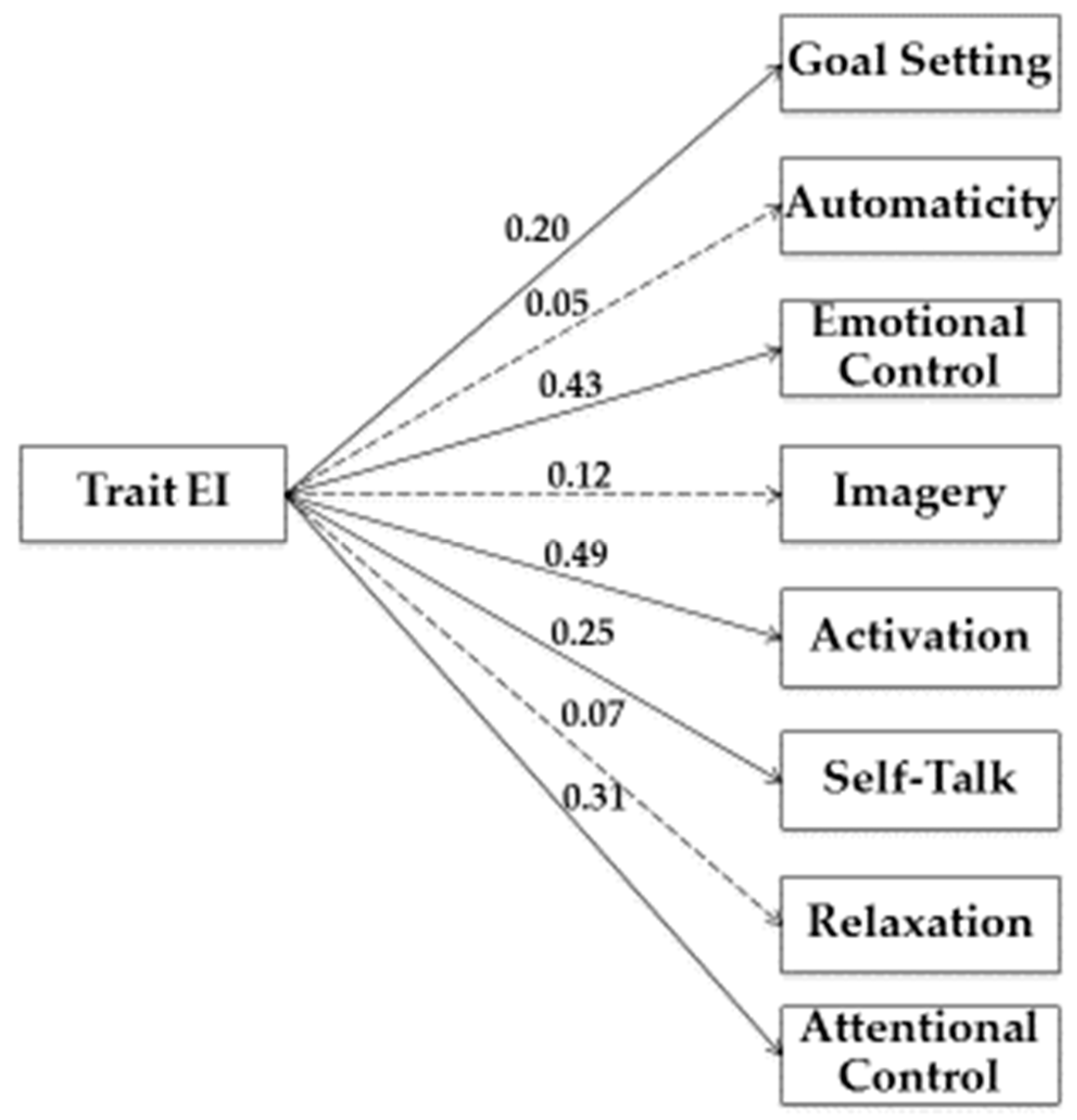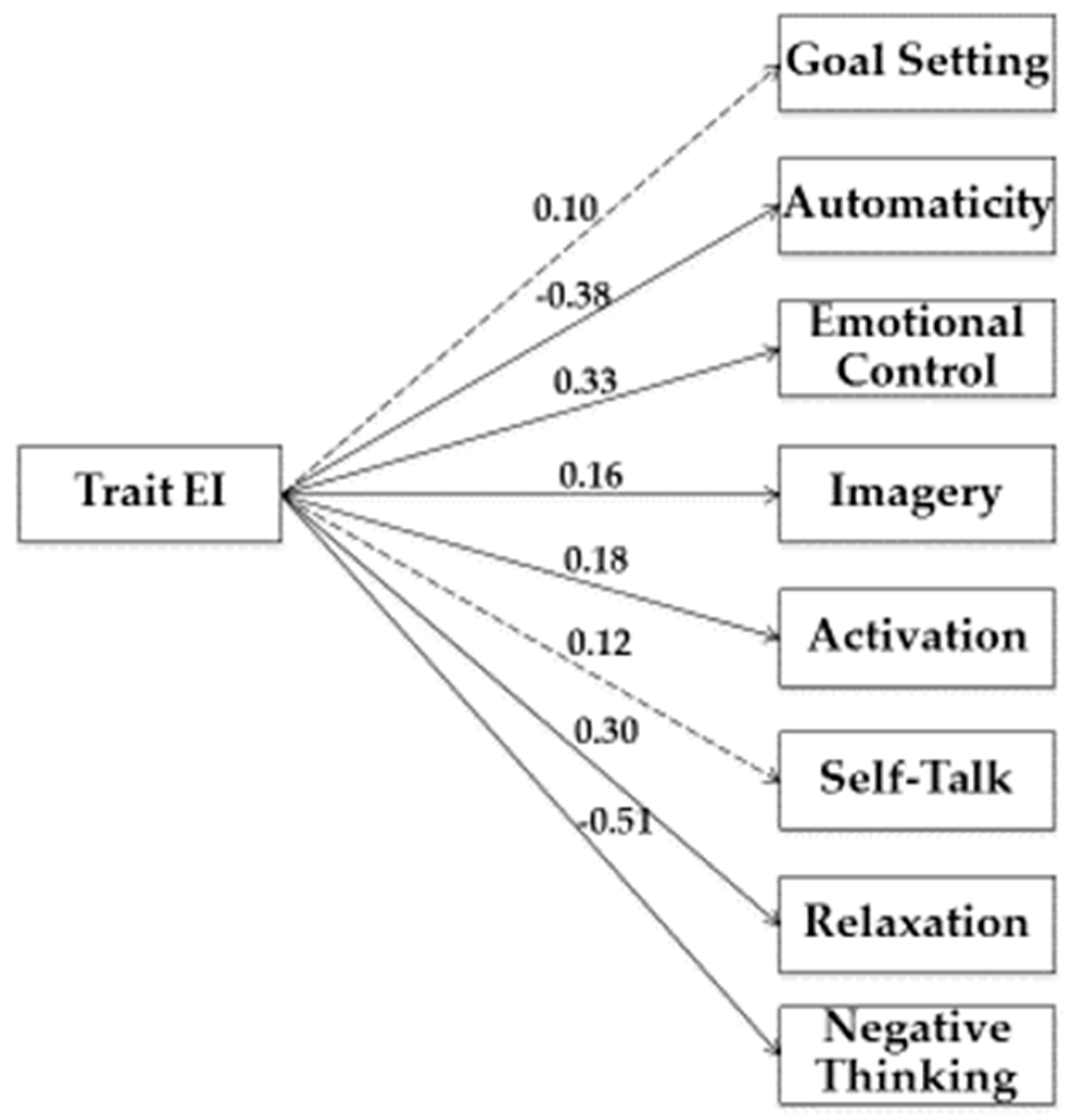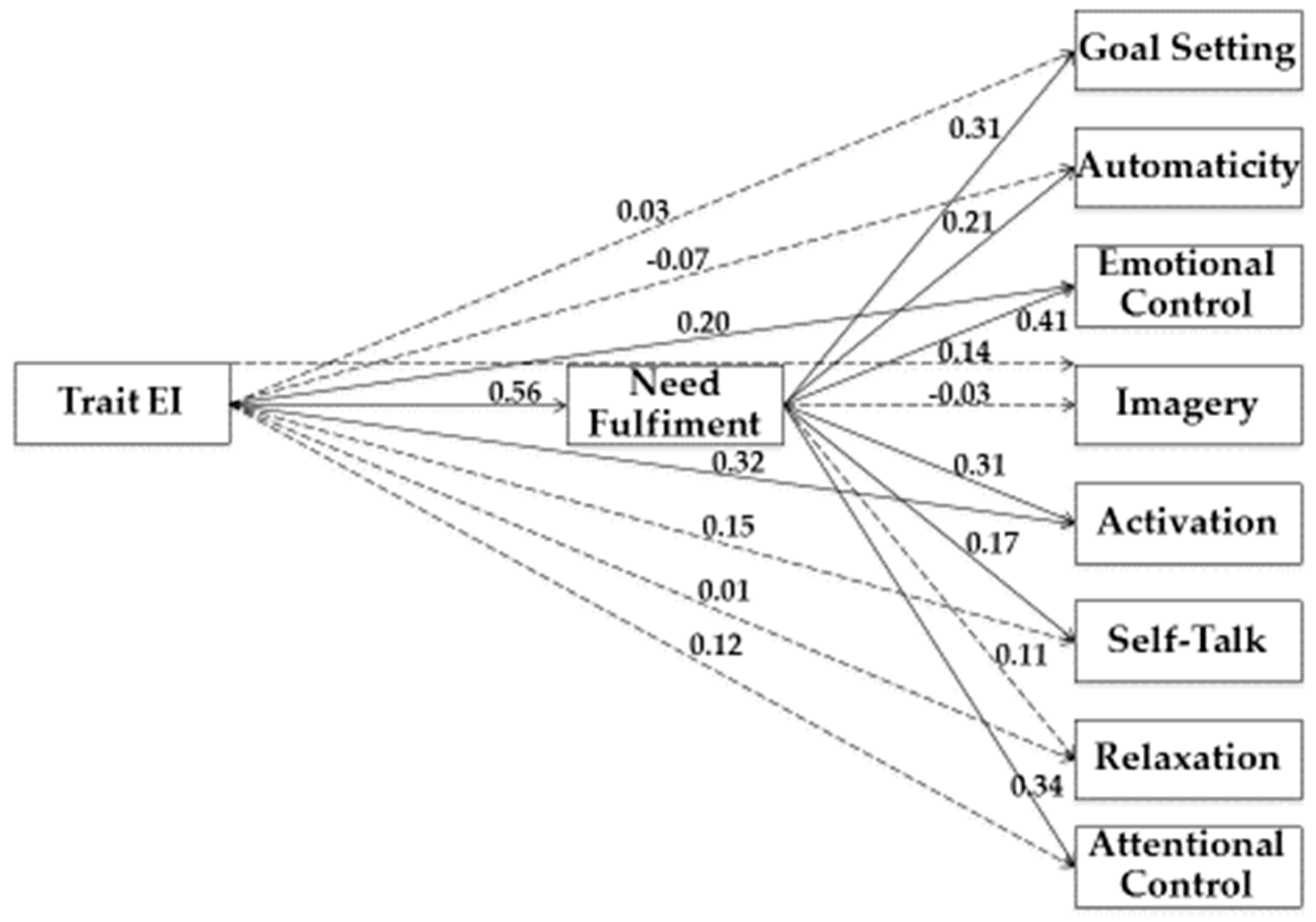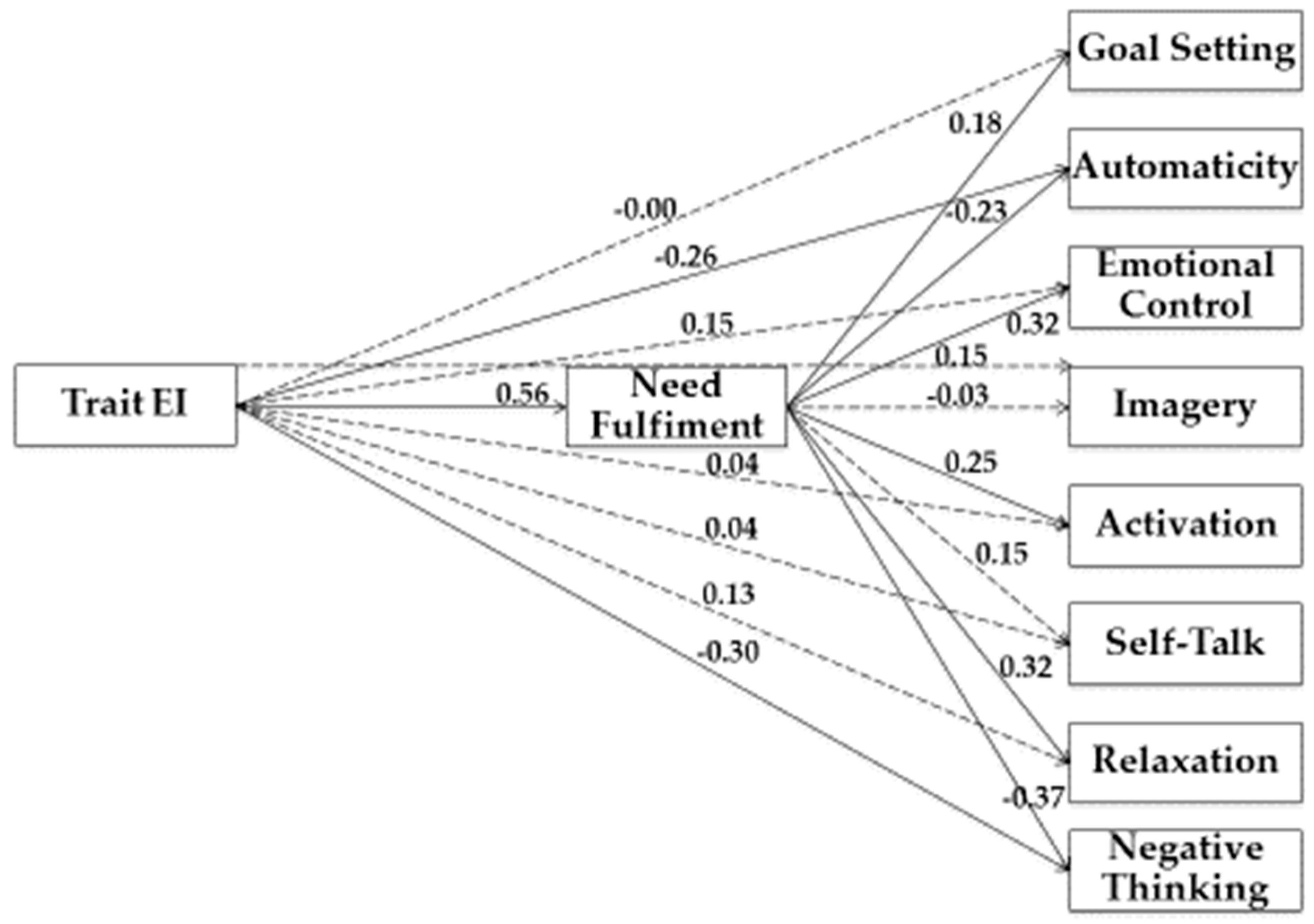Relationships among Trait EI, Need Fulfilment, and Performance Strategies
Abstract
:1. Introduction
1.1. Performance Strategies in Sport
1.2. Trait Emotional Intelligence and Performance Strategies in Sport
1.3. Satisfaction of Basic Needs and Performance Strategies in Sport
1.4. The Present Study
2. Materials and Methods
2.1. Participants
2.2. Measures
2.2.1. Trait EI
2.2.2. Needs
2.2.3. Performance Strategies
2.3. Procedures
2.4. Data Analyses
3. Results
3.1. Descriptive and Correlations
3.2. Mediation Model
4. Discussion
Author Contributions
Funding
Conflicts of Interest
References
- Kopp, A.; Jekauc, D. The Influence of Emotional Intelligence on Performance in Competitive Sports: A Meta-Analytical Investigation. Sports 2018, 6, 175. [Google Scholar] [CrossRef] [PubMed]
- Martinent, G.; Guillet-Descas, E.; Moiret, S. Reliability and validity evidence for the French Psychological Need Thwarting Scale (PNTS) scores: Significance of a distinction between thwarting and satisfaction of satisfaction of basic needs. Psychol. Sport Exerc. 2015, 20, 29–39. [Google Scholar] [CrossRef]
- Lane, A.M.; Devonport, T.J.; Soos, I.; Leibinger, E.; Karsai, I.; Hamar, P. Emotional intelligence, mood states and successful and unsuccessful performance. J. Sports Sci. Med. 2010, 9, 388–392. [Google Scholar] [PubMed]
- Podlog, L.W.; Banham, S.M.; Wadey, R.; Hannon, J. Psychological Readiness to Return to Competitive Sport Following Injury: A Qualitative Study. Sport Psychol. 2015, 29, 1–14. [Google Scholar] [CrossRef]
- Verhagen, E.A.L.M.; van Stralen, M.M.; van Mechelen, W. Behaviour, the Key Factor for Sports Injury Prevention. Sports Med. 2010, 40, 899–906. [Google Scholar] [CrossRef] [PubMed]
- Hardy, L.; Roberts, R.; Thomas, R.; Shane, R. Test of Performance Strategies (TOPS): Instrument refinement using confirmatory factor analysis. Psychol. Sport Exerc. 2010, 11, 27–35. [Google Scholar] [CrossRef]
- Kremer, J.; Moran, A.P. Pure Sport: Practical Sport Psychology; Routledge: London, UK, 2008. [Google Scholar]
- Beckmann, J.; Kellmann, M. Procedures and Principles of Sport Psychological Assessment. Sport Psychol. 2003, 17, 338–350. [Google Scholar] [CrossRef]
- Laborde, S.; Breuer-Weiborn, J.; Dosseville, F. Personality-Trait-Like Individual Differences in Athletes. In Advances in the Psychology of Sports and Exercise; Mohiyeddini, C., Ed.; Nova: New York, NY, USA, 2013; pp. 25–60. [Google Scholar]
- Meyers, A.W.; Whelan, J.P.; Murphy, S.M. Cognitive behavioral strategies in athletic performance enhancement. Prog. Behav. Modif. 1996, 30, 137–164. [Google Scholar]
- Hanin, Y.L. Coping with anxiety in sport. In Coping in Sport: Theory, Methods, and Related Constructs; Nicholls, A.R., Ed.; Nova Science: Hauppauge, NY, USA, 2010. [Google Scholar]
- Ruiz, M.C.; Hanin, Y.L. Perceived impact of anger on performance of skilled karate athletes. Psychol. Sport Exerc. 2011, 12, 242–249. [Google Scholar] [CrossRef]
- Birwatkar, V.P. Emotional Intelligence: The Invisible Phenomenon in Sports. Eur. J. Sports Exerc. Sci. 2014, 3, 19–31. [Google Scholar]
- Tamir, M. What do people want to feel and why? Pleasure and utility in emotion regulation. Curr. Dir. Psychol. Sci. 2009, 18, 101–105. [Google Scholar] [CrossRef]
- Petrides, K.V.; Pita, R.; Kokkinaki, F. The Location of Trait Emotional Intelligence in Personality Factor Space. Br. J. Psychol. 2007, 98, 273–289. [Google Scholar] [CrossRef] [PubMed]
- Ferguson, F.J.; Austin, E.J. Associations of trait and ability emotional intelligence with performance on Theory of Mind tasks in an adult sample. Personal. Individ. Differ. 2010, 49, 414–418. [Google Scholar] [CrossRef]
- Deci, E.L.; Ryan, R.M. Intrinsic Motivation and Self-Determination in Human Behavior; Plenum: New York, NY, USA, 1985. [Google Scholar]
- Deci, E.L.; Ryan, R.M. The “what” and “why” of goal pursuits: Human needs and the self-determination of behavior. Psychol. Inq. 2000, 11, 227–268. [Google Scholar] [CrossRef]
- Ryan, R.M.; Deci, E.L. An overview of self-determination theory: An organismic dialectical perspective. In Handbook of Self-Determination Research; Deci, E.L., Ryan, R.M., Eds.; The University of Rochester Press: Rochester, NY, USA, 2002; pp. 3–33. [Google Scholar]
- Costa, S.; Gugliandolo, M.; Barberis, N.; Cuzzocrea, F.; Liga, F. Antecedents and consequences of parental psychological control and autonomy support: The role of psychological basic needs. J. Soc. Pers. Relatsh. 2019, 36, 1168–1189. [Google Scholar] [CrossRef]
- Ryan, R.M.; Bernstein, J.; Brown, K. Weekends, Work, and Well-Being: Psychological Need Satisfactions and Day of the Week Effects on Mood, Vitality, and Physical Symptoms. J. Soc. Clin. Psychol. 2010, 29, 95–122. [Google Scholar] [CrossRef]
- Gagné, M.; Ryan, R.M.; Bargmann, K. Autonomy support and need satisfaction in the motivation and well-being of gymnasts. J. Appl. Sport Psychol. 2003, 15, 372–390. [Google Scholar] [CrossRef]
- Sarı, I. Satisfaction of basic psychological needs and goal orientation in young athletes: A test of basic psychological needs theory. Kinesiology 2015, 47, 159–168. [Google Scholar]
- Bartholomew, K.; Ntoumanis, N.; Ryan, R.M.; Thøgersen-Ntoumani, C. Psychological Need Thwarting in the Sport Context: Assessing the Darker Side of Athletic Experience. J. Sport Exerc. Psychol. 2011, 33, 75–102. [Google Scholar] [CrossRef] [PubMed] [Green Version]
- Grolnick, W.S. The Psychology of Parental Control: How Well-Meant Parenting Backfires; Erlbaum: Mahwah, NJ, USA, 2003. [Google Scholar]
- Barberis, N.; Costa, S.; Cuzzocrea, F.; Quattropani, M.C. Trait EI in the relationship between needs fulfilment and symptoms and attitudes associated with EDs. Ment. Health Prev. 2018, 10, 50–55. [Google Scholar] [CrossRef]
- Chen, B.; Vansteenkiste, M.; Beyers, W.; Boone, L.; Deci, E.L.; Van der Kaap-Deeder, J.; Duriez, B.; Lens, W.; Matos, L.; Mouratidis, A.; et al. Basic psychological need satisfaction, need frustration, and need strength across four cultures. Motiv. Emot. 2015, 39, 216–236. [Google Scholar] [CrossRef]
- Ahmad, I.; Vansteenkiste, M.; Soenens, B. The Relations of Arab Jordanian Adolescents’ Perceived Maternal Parenting to Teacher-Rated Adjustment and Problems: The Intervening Role of Perceived Need Satisfaction. Dev. Psychol. 2012, 49, 177. [Google Scholar] [CrossRef] [PubMed]
- Petrides, K.V. Technical Manual for the Trait Emotional Intelligence Questionnaires (TEIQue); London Psychometric Laboratory: London, UK, 2009. [Google Scholar]
- Siegling, A.B.; Vesely, A.K.; Petrides, K.V.; Saklofske, D. Incremental validity of the trait emotional intelligence questionnaire-short form. J. Personal. Assess. 2015, 97, 525–535. [Google Scholar] [CrossRef] [PubMed]
- Standage, M.; Duda, J.L.; Ntoumanis, N. A model of contextual motivation in physical education: Using constructs from self-determination and achievement goal theories to predict physical activity intentions. J. Educ. Psychol. 2003, 95, 97–110. [Google Scholar] [CrossRef]
- McAuley, E.; Duncan, T.; Tammen, V.V. Psychometric properties of the intrinsic motivation inventory in a competitive sport setting: A confirmatory factor analysis. Res. Q. Exerc. Sport 1989, 68, 20–32. [Google Scholar] [CrossRef]
- Richer, S.; Vallerand, R.J. Construction and validation of the perceived relatedness scale. Rev. Eur. Psychol. Appl. 1998, 48, 129–137. [Google Scholar]
- Standage, M.; Duda, K.L.; Ntoumanis, N. A test of self-determination theory in school physical education. Br. Psychol. Soc. 2005, 75, 411–433. [Google Scholar] [CrossRef] [Green Version]
- Thomas, P.R.; Murphy, S.M.; Hardy, L. Test of performances strategies: Development and preliminary validation of a comprehensive measure of athletes’ psychological skills. J. Sports Sci. 1999, 17, 697–711. [Google Scholar] [CrossRef]
- Preacher, K.J.; Hayes, A.F. SPSS and SAS procedures for estimating indirect effects in simple mediation models. Behav. Res. Methods Instrum. Comput. 2004, 36, 717–731. [Google Scholar] [CrossRef] [Green Version]
- Shrout, P.E.; Bolger, N. Mediation in experimental and nonexperimental studies: New procedures and recommendations. Psychol. Methods 2002, 7, 422–445. [Google Scholar] [CrossRef]




| α | M | SD | Skew | Kurt | 1 | 2 | 3 | 4 | 5 | 6 | 7 | 8 | 9 | ||
|---|---|---|---|---|---|---|---|---|---|---|---|---|---|---|---|
| 1 | Trait EI | 0.90 | 4.73 | 0.68 | −0.09 | −0.40 | |||||||||
| 2 | Needs Fulfilment | 0.93 | 5.14 | 0.93 | −0.19 | −0.44 | 0.56 ** | ||||||||
| 3 | Goal Setting in training | 0.73 | 3.78 | 0.74 | −0.36 | −0.31 | 0.20 ** | 0.32 ** | |||||||
| 4 | Imagery in training | 0.61 | 3.21 | 0.83 | 0.19 | −0.40 | 0.12 | 0.05 | 0.45 ** | ||||||
| 5 | Relaxation in training | 0.77 | 2.50 | 0.89 | 0.21 | −0.78 | 0.07 | 0.12 | 0.16 * | 0.20 ** | |||||
| 6 | Activation in training | 0.66 | 3.56 | 0.73 | 0.03 | −0.43 | 0.49 ** | 0.49 ** | 0.49 ** | 0.29 ** | 0.15 * | ||||
| 7 | Self-Talk in training | 0.82 | 3.43 | 0.95 | −0.36 | −0.49 | 0.25 ** | 0.25 ** | 0.52 ** | 0.44 ** | 0.37 ** | 0.45 ** | |||
| 8 | Emotional control in training | 0.65 | 3.18 | 0.80 | −0.05 | −0.63 | 0.43 ** | 0.52 ** | 0.03 | 0.06 | 0.15 * | 0.38 ** | 0.30 ** | ||
| 9 | Automaticity in training | 0.62 | 3.10 | 0.57 | −0.02 | −0.16 | 0.05 | 0.17 * | 0.20 ** | 0.10 | 0.26 ** | 0.22 ** | 0.34 ** | 0.15 * | |
| 10 | Attentional Control in training | 0.69 | 3.55 | 0.79 | −0.21 | −0.59 | 0.31 ** | 0.40 ** | 0.45 ** | 0.28 ** | 0.05 | 0.56 ** | 0.31 ** | 0.32 ** | 0.08 |
| α | M | SD | Skew | Kurt | 1 | 2 | 3 | 4 | 5 | 6 | 7 | 8 | 9 | ||
|---|---|---|---|---|---|---|---|---|---|---|---|---|---|---|---|
| 1 | Trait EI | 0.90 | 4.73 | 0.68 | −0.09 | −0.40 | |||||||||
| 2 | Needs Fulfilment | 0.93 | 5.14 | 0.93 | −0.19 | −0.44 | 0.56 ** | ||||||||
| 3 | Goal Setting in competition | 0.79 | 3.66 | 0.84 | −0.16 | −0.78 | 0.10 | 0.18 * | |||||||
| 4 | Imagery in competition | 0.76 | 3.39 | 0.87 | −0.08 | −0.54 | 0.16 * | 0.19 ** | 0.54 ** | ||||||
| 5 | Relaxation in competition | 0.79 | 3.02 | 0.87 | −0.15 | −0.27 | 0.30 ** | 0.39 ** | 0.14 * | 0.40 ** | |||||
| 6 | Activation in competition | 0.75 | 3.64 | 0.74 | −0.07 | −0.74 | 0.18 * | 0.27 ** | 0.54 ** | 0.57 ** | 0.45 ** | ||||
| 7 | Self-Talk in competition | 0.83 | 3.37 | 0.96 | −0.38 | −0.43 | 0.12 | 0.17 * | 0.44 ** | 0.54 ** | 0.36 ** | 0.64 ** | |||
| 8 | Emotional control in competition | 0.62 | 3.31 | 0.84 | −0.25 | −0.44 | 0.33 ** | 0.41 ** | 0.03 | 0.18 | 0.55 ** | 0.24 ** | 0.14 | ||
| 9 | Automaticity in competition | 0.60 | 2.36 | 0.69 | 0.20 | −0.53 | −0.38 | −0.37 ** | −0.19 * | −0.26 ** | −0.26 | −0.27 ** | −0.17 * | −0.42 ** | |
| 10 | Negative Thinking in competition | 0.72 | 2.34 | 0.82 | 0.43 | −0.47 | −0.51 ** | −0.54 ** | −0.13 | −0.24 ** | −0.51 ** | −0.32 ** | −0.27 ** | −0.58 ** | 0.37 ** |
| β | Lower Bound (BC) 95% CI | Upper Bound (BC) 95% CI | |
|---|---|---|---|
| Direct Effects | |||
| Trait EI → Need Fulfilment | 0.56 | 0.45 | 0.65 |
| Trait EI → Goal Set | 0.03 | −0.13 | 0.19 |
| Trait EI → Automaticity | −0.07 | −0.23 | 0.11 |
| Trait EI → Emotional Control | 0.20 | 0.05 | 0.33 |
| Trait EI → Imagery | 0.14 | −0.04 | 0.30 |
| Trait EI → Activation | 0.32 | 0.16 | 0.47 |
| Trait EI → Self-Talk | 0.15 | −0.01 | 0.30 |
| Trait EI → Relaxation | 0.01 | −0.16 | 0.18 |
| Trait EI → Attentional Control | 0.12 | −0.04 | 0.27 |
| Need Fulfilment → Goal Setting | 0.31 | 0.14 | 0.46 |
| Need Fulfilment → Automaticity | 0.21 | 0.06 | 0.36 |
| Need Fulfilment → Emotional Control | 0.41 | 0.27 | 0.55 |
| Need Fulfilment → Imagery | −0.03 | −0.19 | 0.14 |
| Need Fulfilment → Activation | 0.31 | 0.15 | 0.47 |
| Need Fulfilment → Self-Talk | 0.17 | 0.01 | 0.32 |
| Need Fulfilment → Relaxation | 0.11 | −0.09 | 0.32 |
| Need Fulfilment → Attentional Control | 0.34 | 0.19 | 0.47 |
| Indirect Effects | |||
| Trait EI → Need Fulfilment → Goal Setting | 0.17 | 0.08 | 0.27 |
| Trait EI → Need Fulfilment → Automaticity | 0.12 | 0.04 | 0.21 |
| Trait EI → Need Fulfilment → Emotional Control | 0.23 | 0.15 | 0.33 |
| Trait EI → Need Fulfilment → Imagery | −0.02 | −0.11 | 0.08 |
| Trait EI → Need Fulfilment → Activation | 0.17 | 0.08 | 0.28 |
| Trait EI → Need Fulfilment → Self-Talk | 0.09 | 0.01 | 0.19 |
| Trait EI → Need Fulfilment → Relaxation | 0.06 | −0.05 | 0.18 |
| Trait EI → Need Fulfilment → Attentional Control | 0.19 | 0.11 | 0.28 |
| Total Effects | |||
| Trait EI → Goal Setting | 0.20 | 0.06 | 0.33 |
| Trait EI → Automaticity | 0.05 | −0.10 | 0.21 |
| Trait EI → Emotional Control | 0.43 | 0.31 | 0.52 |
| Trait EI → Imagery | 0.12 | −0.02 | 0.26 |
| Trait EI → Activation | 0.49 | 0.37 | 0.60 |
| Trait EI → Self-Talk | 0.25 | 0.10 | 0.38 |
| Trait EI → Relaxation | 0.07 | −0.07 | 0.20 |
| Trait EI → Attentional Control | 0.31 | 0.18 | 0.43 |
| Need Fulfilment → Goal Setting | 0.31 | 0.14 | 0.46 |
| Need Fulfilment → Automaticity | 0.21 | 0.06 | 0.36 |
| Need Fulfilment → Emotional Control | 0.41 | 0.27 | 0.55 |
| Need Fulfilment → Imagery | −0.03 | −0.19 | 0.14 |
| Need Fulfilment → Activation | 0.31 | 0.15 | 0.47 |
| Need Fulfilment → Self-Talk | 0.17 | 0.01 | 0.32 |
| Need Fulfilment → Relaxation | 0.11 | −0.09 | 0.32 |
| Need Fulfilment → Attentional Control | 0.34 | 0.19 | 0.47 |
| β | Lower Bound (BC) 95% CI | Upper Bound (BC) 95% CI | |
|---|---|---|---|
| Direct Effects | |||
| Trait EI → Need Fulfilment | 0.56 | 0.45 | 0.65 |
| Trait EI → Goal Set | −0.00 | −0.16 | 0.16 |
| Trait EI → Automaticity | −0.26 | −0.43 | −0.07 |
| Trait EI → Emotional Control | 0.15 | −0.01 | 0.31 |
| Trait EI → Imagery | 0.07 | −0.10 | 0.23 |
| Trait EI → Activation | 0.04 | −0.13 | 0.21 |
| Trait EI → Self-Talk | 0.04 | −0.12 | 0.20 |
| Trait EI → Relaxation | 0.13 | −0.05 | 0.30 |
| Trait EI → Negative Thinking | −0.30 | −0.44 | −0.16 |
| Need Fulfilment → Goal Setting | 0.18 | 0.01 | 0.34 |
| Need Fulfilment → Automaticity | −0.23 | −0.40 | −0.05 |
| Need Fulfilment → Emotional Control | 0.32 | 0.18 | 0.46 |
| Need Fulfilment → Imagery | 0.15 | −0.00 | 0.29 |
| Need Fulfilment → Activation | 0.25 | 0.09 | 0.40 |
| Need Fulfilment → Self-Talk | 0.15 | 0.01 | 0.30 |
| Need Fulfilment → Relaxation | 0.32 | 0.15 | 0.47 |
| Need Fulfilment → Negative Thinking | −0.37 | −0.50 | −0.24 |
| Indirect Effects | |||
| Trait EI → Need Fulfilment → Goal Setting | 0.10 | 0.01 | 0.20 |
| Trait EI → Need Fulfilment → Automaticity | −0.13 | −0.23 | −0.03 |
| Trait EI → Need Fulfilment → Emotional Control | 0.18 | 0.10 | 0.27 |
| Trait EI → Need Fulfilment → Imagery | 0.09 | 0.00 | 0.17 |
| Trait EI → Need Fulfilment → Activation | 0.14 | 0.05 | 0.24 |
| Trait EI → Need Fulfilment → Self-Talk | 0.08 | −0.01 | 0.17 |
| Trait EI → Need Fulfilment → Relaxation | 0.18 | 0.09 | 0.27 |
| Trait EI → Need Fulfilment → Negative Thinking | −0.21 | −0.30 | −0.13 |
| Total Effects | |||
| Trait EI → Goal Setting | 0.10 | −0.04 | 0.24 |
| Trait EI → Automaticity | −0.38 | −0.50 | −0.25 |
| Trait EI → Emotional Control | 0.33 | 0.20 | 0.45 |
| Trait EI → Imagery | 0.16 | 0.01 | 0.30 |
| Trait EI → Activation | 0.18 | 0.03 | 0.32 |
| Trait EI → Self-Talk | 0.12 | −0.03 | 0.26 |
| Trait EI → Relaxation | 0.30 | 0.16 | 0.43 |
| Trait EI → Negative Thinking | −0.51 | −0.60 | −0.40 |
| Need Fulfilment → Goal Setting | 0.18 | 0.01 | 0.34 |
| Need Fulfilment → Automaticity | −0.23 | −0.40 | −0.05 |
| Need Fulfilment → Emotional Control | 0.32 | 0.18 | 0.46 |
| Need Fulfilment → Imagery | 0.15 | −0.00 | 0.29 |
| Need Fulfilment → Activation | 0.25 | 0.09 | 0.40 |
| Need Fulfilment → Self-Talk | 0.15 | −0.01 | 0.30 |
| Need Fulfilment → Relaxation | 0.32 | 0.15 | 0.47 |
| Need Fulfilment → Negative Thinking | −0.37 | −0.50 | −0.24 |
© 2019 by the authors. Licensee MDPI, Basel, Switzerland. This article is an open access article distributed under the terms and conditions of the Creative Commons Attribution (CC BY) license (http://creativecommons.org/licenses/by/4.0/).
Share and Cite
Barberis, N.; Calaresi, D.; Gugliandolo, M.C. Relationships among Trait EI, Need Fulfilment, and Performance Strategies. J. Funct. Morphol. Kinesiol. 2019, 4, 50. https://doi.org/10.3390/jfmk4030050
Barberis N, Calaresi D, Gugliandolo MC. Relationships among Trait EI, Need Fulfilment, and Performance Strategies. Journal of Functional Morphology and Kinesiology. 2019; 4(3):50. https://doi.org/10.3390/jfmk4030050
Chicago/Turabian StyleBarberis, Nadia, Danilo Calaresi, and Maria Cristina Gugliandolo. 2019. "Relationships among Trait EI, Need Fulfilment, and Performance Strategies" Journal of Functional Morphology and Kinesiology 4, no. 3: 50. https://doi.org/10.3390/jfmk4030050





